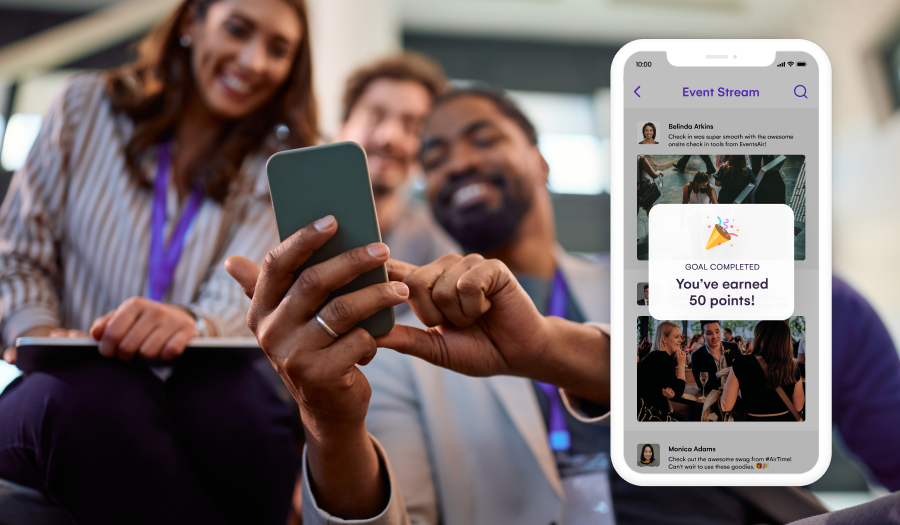Planning for a Smooth Onsite Check-In Experience

Whether you have 30 or 30,000 people at your event, the event check-in process is equally as important (and can be equally as stressful). Event check-in is like a symphony orchestra of registrations, name badges, signage, VIPs and check-in kiosks, and you, the event organizer, are the conductor, doing your darndest to ensure it all flows and not a note is played out of tune.
This is because a smooth, efficient and convenient check-in process can mean the difference between frazzled, unimpressed guests who turn their frustrations towards your event, and those who, after having a great check-in experience, are more likely to be positive and confident about what’s to come.
In this article, we provide tips to make the event check-in process as streamlined and seamless as possible.
Check-in is just the beginning, learn more about event planning process from start to finish.
1. Encourage pre-registration
Our first tip starts long before the event does. Encourage attendees to pre-register so you can gather attendee information in advance and use this to more accurately forecast final numbers.
Staged ticket releases can facilitate early registrations (e.g. early bird, first release, second release), enabling your team to prepare registration materials, print badges, and have everything ready for a swift check-in experience.
2. Optimize your check-in layout
Long before your event starts, you’ll also want to start planning out how your actual check-in area will look and operate to facilitate fast and pain-free check-in for everyone (yourself included!). Here are some things to think about:
- Check-in location: situate your check-in area somewhere that’s logical and easy for attendees to find and access (e.g. next to the entrance).
- Attendee flow: map out your check-in area to visualize the flow of people from transport to the entrance, through check-in and onto the various halls, breakout rooms, etc. This will also help to identify how much space you have to play with and what other equipment you’ll need (e.g. chairs, stanchions, sign-holders).
- Signage: use clear signage (digital or physical) to guide attendees effectively.
- Self-check-in: allow attendees to check themselves in at kiosks using QR codes or registration numbers to speed up check-in and free up staff.
- Priority check-in: allocate the various attendee or ticket types to different stations or doors (e.g. VIP, general, pre-registered, unregistered/walk-ins). A designated check-in to expedite VIPs, speakers, vendors, and/or staff ensures they receive prompt and personalized service.
- Queues: designate an area for the queue with velvet ropes, stanchions, floor markers, signage or people so that attendees don’t congregate haphazardly around a check-in counter blocking the flow.
- Help desk: set up your help desk near the check-in so that it’s easy for people with questions or issues to access, rather than have them congesting the check-in.
- Cloakroom/bag check: situate the cloakroom closeby to check-in and ensure the process is efficient and well-organized so that collecting items on the way out is also hassle-free.
- Involve key stakeholders: share your check-in layout and plan with key stakeholders prior to your event for feedback and approval (e.g. the venue, fire marshall, events team).
3. Leverage event registration technology
Paper and pen will always hold a special place in our hearts, but you know what we love more? Technology. Hurriedly trying to find names on a guest list on a clipboard or in a book is fun for no one, especially when you have to recite the alphabet in your head to remember if “w” comes before or after “u” and ask the client to spell their name for the 3rd time.
But circumventing this awkwardness is the least that event registration tech can do. Whether it’s a check-in app, dedicated event registration software or a comprehensive event management platform like EventsAir, here are a few of our favorite things that tech can do:
- Automate and speed up the check-in process: automatically processing, scanning, and/or validating digital or printed tickets, QR codes, or registration numbers.
- Take payments: for walk-ins or attendees whose accounts are not paid in full.
- Streamline data collection and management: whether it’s through an online registration form or a check-in app to register walk-ins on the day, using tech will help to ensure attendee data is captured consistently, reducing the chance of errors and providing one accessible source of truth for everything (“let’s check the dietaries one more time”).
- Print badges: if your app is connected to a badge printer you can print people’s badges on the spot, as needed, rather than searching through masses of names on a table (also helpful when there are last-minute changes that need to be made for typos or preferred names and prevents wastage for no-shows).
- Access real-time updates and analytics: track attendees, monitor check-in flow, and gather data for post-event analysis to optimize the event experience for next time.
Since EventsAir was integrated with our onsite registration kiosks, check-in has become so much faster, smoother and more flexible for our attendees.
Luca De Giuseppe, Head of Digital, Campaigns, and Tools (EU/UK). Read the Klay and TCS Summit Europe case study.
READ NEXT: How to produce event marketing that actually gets noticed, read & leads to paid registration
4. Prepare your materials (and prepare back-up)
Organize all necessary materials, such as hardware, software, stationery, name tags, pins, lanyards, SWAG bags, and collateral and have them delivered and set up at the venue prior to event day. You never know when technology will fail you though – printers jam, the internet drops out, and the scissors go missing, so it never hurts anyone to have a backup. For example:
- Extra printers and computers that have software loaded (including ink and chargers).
- Extra stationery supplies – pens, scissors, extra badge holders, glue, tape, white-out, folders, paper.
- Backed-up database on USBs and another device in case of corruption.
- Hard copy check-in list (remember we said paper will always hold a special place in our heart) and/or a full set of name badges as PDF files saved onto a couple of USBs.
- Connectivity. Ensure the venue’s internet is compartmentalized from the guest wireless network. Have a backup mobile hotspot or BYO 4G router with 4G sim card that can automatically switch to an external data service if there’s an outage.
- Wired connections for your onsite check-in and office needs.
5. Test your technology
No matter how many conferences you have organized, you’ll know that testing your tech early, and testing often (because things can change) is the best way to identify problems early, fix them, and avoid mishaps on the day, Further to this, involving other staff in testing can bring unique viewpoints and issues to light. The list below is by no means exhaustive, but here are a few things to put on your test list.
- Registration e.g. self-registration, assisted registration, manual check-in, un-registered guests, scanning QR codes on paper and mobile devices.
- All hardware including computers and printers and QR code scanners (and using them on the on-site wireless network).
- Using your event registration software on multiple devices and operating systems (e.g. iPad, mobile, laptop, Mac, Windows, iPhone, Android).
Though you can do all the testing in the world, sometimes your tech might still fail on the day. Depending on the size of your event, either having an on-site tech support person or access to a tech support team like EventsAir’s 24/7 support can help resolve problems quickly if they do come up.
6. Communicate with your attendees
Educating your attendees about the check-in process before they even get to the event can help to avoid confusion and headaches (“this place is massive, where do I go?“) once they arrive.
Schedule a reminder email to attendees for the night before the event with clear and concise information about check-in. This will hopefully keep the important bits fresh in their minds and if not, give them something tangible to refer to if needed.
Here are some things you might like to include in the email:
- Location of the event and map.
- Venue layout highlighting the check-in desks.
- What to bring (e.g. ID, QR code).
- The schedule.
- Support contacts.
But the communication doesn’t stop there. Once your attendees are safely in the door, keep them informed, engaged, and making the most out of their time with signage, visuals, email social media, and app updates.
Tip: a custom event app makes check-in easy for attendees by providing access to important info on the go and allowing you to send last-minute push notifications if anything changes. Read more about how you can boost onsite engagement with an event mobile app.
7. Staffing
Assign knowledgeable, personable, and well-trained staff and/or volunteers to the door/check-in area. Ensure they have the training and tools to provide guidance, answer questions, and address any concerns promptly and professionally.
Research shows that people often learn better by doing than by seeing or hearing. Role-playing sample scenarios can equip staff with the knowledge and confidence to answer questions and assist attendees efficiently. Here are a few examples of scenarios you could role play:
- Using the check-in technology, loading name badge stock and printer consumables.
- Mock check-in experience where various problems arise – some of the examples we mentioned in the test section above.
- Answering questions attendees might ask.
- Handling customer service issues and problems, including when and how to escalate them.
Remember a smile and warm approach can help to defuse most situations and can enhance the overall experience.
8. Delegate authority
There is never enough time during a conference for someone to have to seek you out for your permission, especially during a busy onsite check-in. As a professional organizer it is vital to delegate appropriately and make sure authority is extended along with appropriate responsibility.
How to hold others accountable
- Start each morning with a kick-off meeting, reviewing expected check-in numbers and special challenges, such as VIP check-in or dealing with unpaid onsite registrations.
- Engage an on-site supervisor for contracted staff
- Volunteer coordinator for volunteers
- Equally, it’s important that staff can contact you immediately via cell or radio if there is a problem.
9. Document your event processes
As with everything in events, if it’s not written down, it may as well not exist.
Document all check-in processes and technology and provide your team, onsite staff and any other relevant people with a simple set of guidelines (printed and digital) that they can refer to during training and the actual event. This reduces the need for you to be there during training, the risk of relying on you if you are tied up elsewhere, and ensures consistency and enhances quality.
10. Power the “wow”
Check-in is typically the first physical touch-point attendees will have with your event and brand. First impressions count, and can set the tone for a more positive experience with the event itself.
EventsAir has been helping power the wow in events for over 30 years, and our comprehensive and scalable technology can help you create a streamlined, seamless event check-in experience that will certainly wow your attendees.
But outside of that here are a few of our other ideas to wow your attendees, making them feel special before they get in the door (as a bonus, these can also help distract from lines, should there be any).
- Colourful, Instagrammable signage and decorations.
- Competitions or activations that can be entered into at check-in.
- Entertainment such as dancers, interviewers, or live speakers.
- Technology like VR, augmented reality, AI, or robots.
- Videos teasers of the event that’s to come or a live feed from inside.
- Hand out some SWAG before they even get in the door.
- Food and drinks (everyone loves a treat)
Get a free demo to see how EventsAir can power your next event.



